Diurnal rhythms in neurexins transcripts and inhibitory/excitatory synapse scaffold proteins in the biological clock
- PMID: 22662246
- PMCID: PMC3360661
- DOI: 10.1371/journal.pone.0037894
Diurnal rhythms in neurexins transcripts and inhibitory/excitatory synapse scaffold proteins in the biological clock
Abstract
The neurexin genes (NRXN1/2/3) encode two families (α and β) of highly polymorphic presynaptic proteins that are involved in excitatory/inhibitory synaptic balance. Recent studies indicate that neuronal activation and memory formation affect NRXN1/2/3α expression and alternative splicing at splice sites 3 and 4 (SS#3/SS#4). Neurons in the biological clock residing in the suprachiasmatic nuclei of the hypothalamus (SCN) act as self-sustained oscillators, generating rhythms in gene expression and electrical activity, to entrain circadian bodily rhythms to the 24 hours day/night cycles. Cell autonomous oscillations in NRXN1/2/3α expression and SS#3/SS#4 exons splicing and their links to rhythms in excitatory/inhibitory synaptic balance in the circadian clock were explored. NRXN1/2/3α expression and SS#3/SS#4 splicing, levels of neurexin-2α and the synaptic scaffolding proteins PSD-95 and gephyrin (representing excitatory and inhibitory synapses, respectively) were studied in mRNA and protein extracts obtained from SCN of C3H/J mice at different times of the 24 hours day/night cycle. Further studies explored the circadian oscillations in these components and causality relationships in immortalized rat SCN2.2 cells. Diurnal rhythms in mNRXN1α and mNRXN2α transcription, SS#3/SS#4 exon-inclusion and PSD-95 gephyrin and neurexin-2α levels were found in the SCN in vivo. No such rhythms were found with mNRXN3α. SCN2.2 cells also exhibited autonomous circadian rhythms in rNRXN1/2 expression SS#3/SS#4 exon inclusion and PSD-95, gephyrin and neurexin-2α levels. rNRXN3α and rNRXN1/2β were not expressed. Causal relationships were demonstrated, by use of specific siRNAs, between rNRXN2α SS#3 exon included transcripts and gephyrin levels in the SCN2.2 cells. These results show for the first time dynamic, cell autonomous, diurnal rhythms in expression and splicing of NRXN1/2 and subsequent effects on the expression of neurexin-2α and postsynaptic scaffolding proteins in SCN across the 24-h cycle. NRXNs gene transcripts may have a role in coupling the circadian clock to diurnal rhythms in excitatory/inhibitory synaptic balance.
Conflict of interest statement
Figures
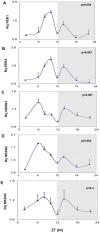
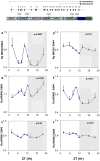

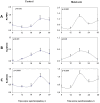
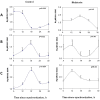


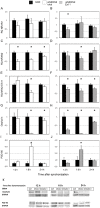
Similar articles
-
Oscillating on borrowed time: diffusible signals from immortalized suprachiasmatic nucleus cells regulate circadian rhythmicity in cultured fibroblasts.J Neurosci. 2001 Oct 15;21(20):7937-43. doi: 10.1523/JNEUROSCI.21-20-07937.2001. J Neurosci. 2001. PMID: 11588167 Free PMC article.
-
Dynamic changes in neurexins' alternative splicing: role of Rho-associated protein kinases and relevance to memory formation.PLoS One. 2011 Apr 12;6(4):e18579. doi: 10.1371/journal.pone.0018579. PLoS One. 2011. PMID: 21533271 Free PMC article.
-
Differential maturation of circadian rhythms in clock gene proteins in the suprachiasmatic nucleus and the pars tuberalis during mouse ontogeny.Eur J Neurosci. 2009 Feb;29(3):477-89. doi: 10.1111/j.1460-9568.2008.06605.x. Eur J Neurosci. 2009. PMID: 19222558 Free PMC article.
-
GABAergic mechanisms in the suprachiasmatic nucleus that influence circadian rhythm.J Neurochem. 2021 Apr;157(1):31-41. doi: 10.1111/jnc.15012. Epub 2020 Jul 3. J Neurochem. 2021. PMID: 32198942 Review.
-
Encoding the ins and outs of circadian pacemaking.J Biol Rhythms. 2006 Dec;21(6):470-81. doi: 10.1177/0748730406294316. J Biol Rhythms. 2006. PMID: 17107937 Review.
Cited by
-
External and circadian inputs modulate synaptic protein expression in the visual system of Drosophila melanogaster.Front Physiol. 2014 Apr 3;5:102. doi: 10.3389/fphys.2014.00102. eCollection 2014. Front Physiol. 2014. PMID: 24772085 Free PMC article.
-
Orbitofrontal intronic circular RNA from Nrxn3 mediates reward learning and motivation for reward.Prog Neurobiol. 2024 Jan;232:102546. doi: 10.1016/j.pneurobio.2023.102546. Epub 2023 Nov 29. Prog Neurobiol. 2024. PMID: 38036039 Free PMC article.
-
Splice-dependent trans-synaptic PTPδ-IL1RAPL1 interaction regulates synapse formation and non-REM sleep.EMBO J. 2020 Jun 2;39(11):e104150. doi: 10.15252/embj.2019104150. Epub 2020 Apr 29. EMBO J. 2020. PMID: 32347567 Free PMC article.
-
Promoter-like sequences regulating transcriptional activity in neurexin and neuroligin genes.J Neurochem. 2013 Oct;127(1):36-47. doi: 10.1111/jnc.12372. Epub 2013 Aug 21. J Neurochem. 2013. PMID: 23875667 Free PMC article.
-
Targeting the circadian modulation: novel therapeutic approaches in the management of ASD.Front Psychiatry. 2024 Oct 11;15:1451242. doi: 10.3389/fpsyt.2024.1451242. eCollection 2024. Front Psychiatry. 2024. PMID: 39465045 Free PMC article. Review.
References
-
- Ushkaryov YA, Petrenko AG, Geppert M, Sudhof TC. Neurexins: synaptic cell surface proteins related to the alpha-latrotoxin receptor and laminin. Science. 1992;257:50–56. - PubMed
-
- Ushkaryov YA, Hata Y, Ichtchenko K, Moomaw C, Afendis S, et al. Conserved domain structure of beta-neurexins. Unusual cleaved signal sequences in receptor-like neuronal cell-surface proteins. J Biol Chem. 1994;269:11987–11992. - PubMed
-
- Missler M, Sudhof TC. Neurexins: three genes and 1001 products. Trends Genet. 1998;14:20–26. - PubMed
-
- Ullrich B, Ushkaryov YA, Sudhof TC. Cartography of neurexins: more than 1000 isoforms generated by alternative splicing and expressed in distinct subsets of neurons. Neuron. 1995;14:497–507. - PubMed
Publication types
MeSH terms
Substances
LinkOut - more resources
Full Text Sources
Molecular Biology Databases

